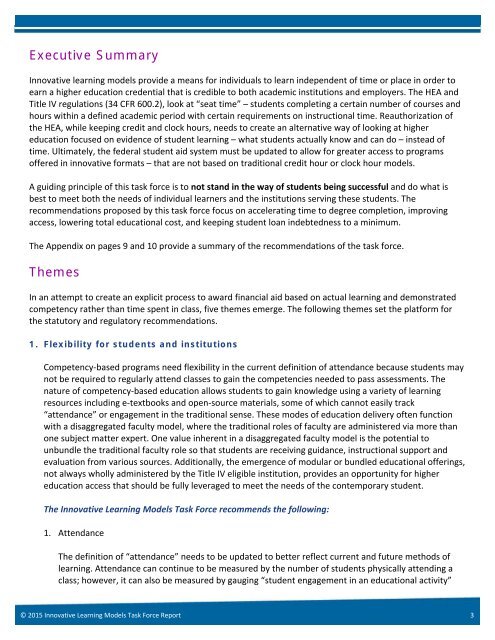INNOVATIVE LEARNING MODELS
Innovative_Learning_ModelsTFReport
Innovative_Learning_ModelsTFReport
You also want an ePaper? Increase the reach of your titles
YUMPU automatically turns print PDFs into web optimized ePapers that Google loves.
Executive SummaryInnovative learning models provide a means for individuals to learn independent of time or place in order toearn a higher education credential that is credible to both academic institutions and employers. The HEA andTitle IV regulations (34 CFR 600.2), look at “seat time” – students completing a certain number of courses andhours within a defined academic period with certain requirements on instructional time. Reauthorization ofthe HEA, while keeping credit and clock hours, needs to create an alternative way of looking at highereducation focused on evidence of student learning – what students actually know and can do – instead oftime. Ultimately, the federal student aid system must be updated to allow for greater access to programsoffered in innovative formats – that are not based on traditional credit hour or clock hour models.A guiding principle of this task force is to not stand in the way of students being successful and do what isbest to meet both the needs of individual learners and the institutions serving these students. Therecommendations proposed by this task force focus on accelerating time to degree completion, improvingaccess, lowering total educational cost, and keeping student loan indebtedness to a minimum.The Appendix on pages 9 and 10 provide a summary of the recommendations of the task force.ThemesIn an attempt to create an explicit process to award financial aid based on actual learning and demonstratedcompetency rather than time spent in class, five themes emerge. The following themes set the platform forthe statutory and regulatory recommendations.1. Flexibility for students and institutionsCompetency-based programs need flexibility in the current definition of attendance because students maynot be required to regularly attend classes to gain the competencies needed to pass assessments. Thenature of competency-based education allows students to gain knowledge using a variety of learningresources including e-textbooks and open-source materials, some of which cannot easily track“attendance” or engagement in the traditional sense. These modes of education delivery often functionwith a disaggregated faculty model, where the traditional roles of faculty are administered via more thanone subject matter expert. One value inherent in a disaggregated faculty model is the potential tounbundle the traditional faculty role so that students are receiving guidance, instructional support andevaluation from various sources. Additionally, the emergence of modular or bundled educational offerings,not always wholly administered by the Title IV eligible institution, provides an opportunity for highereducation access that should be fully leveraged to meet the needs of the contemporary student.The Innovative Learning Models Task Force recommends the following:1. AttendanceThe definition of “attendance” needs to be updated to better reflect current and future methods oflearning. Attendance can continue to be measured by the number of students physically attending aclass; however, it can also be measured by gauging “student engagement in an educational activity”© 2015 Innovative Learning Models Task Force Report 3



